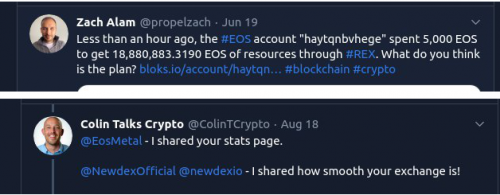Earlier this year, an EOS holding account spent 5,000 EOS to obtain 18,880,883.3190 EOS of resources. This was done via the REX.

—
The original post was make by Eoswriter: https://www.eoswriter.io/162084_newdex-a-dex-with-smooth-ux-and-free-cpu.eos
Earlier this year, an EOS holding account spent 5,000 EOS to obtain 18,880,883.3190 EOS of resources. This was done via the REX. The REX is a resource exchange that enables EOS token- holders to lease out their unused EOS tokens to other DApps in need of network resources. After this transaction had been executed, many people wondered if the lender had mistakenly bought resources instead of leasing his EOS for other developers to temporarily acquire network resources.
How was it possible to make this kind of mistake? (Assuming that it was actually a mistake after all). The account holder remained silent about the incident. Perhaps the account holder had a poor understanding of how the resource exchange worked? Another explanation arose. This mistake happened because the DApp that the account holder used had a poorly designed user interface, thus making it easy for the account holder to confuse between borrowing and lending.
There was even a kind offer from the EOS community to raise funds and reimburse the account for its losses.
Although such altruistic gestures are very welcome and what one hopes will be part of the EOS blockchain community, we cannot allow other accounts to be subject to such ‘mistakes’ whether that be through lack of understanding or through poorly designed tools.
Newdex UX Minimizes Ambiguity
Newdex is the largest decentralised exchange running on the EOS blockchain. The user interface has been designed to minimize any ambiguity. Users are safe-guarded from buying network resources when their true intentions are to rent these resources. After logging in with a wallet of your choice you can navigate over to the resources market which is found underneath the tab for EOS mainnet. Once there you’ll see that REX, RAM, and CPU and NET are all listed separately. Click on any of these products and you are taken to a separate page each with its own clear description of what these products are; a candle-stick chart depicting the financial health of each product, and the ability to create a buyer’s, seller’s, or renter’s market. The users-interface compartmentalises these products, thereby lessening the chances of mistakenly buying one in place of another. This clear easy-to-follow design of the Newdex exchange has received applause from many EOS personalities.
More Headline Grabbing News
From its inception the REX became a firm part of the conversation surrounding the EOS network. Another big headline that involved the REX was caused by Block.one.
This unstaking of 9.8 million EOS tokens and the subsequent purchase of RAM got many people talking. Much of the hype created from this purchase was due to the huge volume of tokens and RAM involved. However, this purchase also sparked a new discussion in the community. Months later a tweet began circulating:
This tweet referred to the huge purchase made by Block.one early during the year. It was also a response to a tweet made by Dan Larimer.
This exacerbated an on-going debate within the EOS developer’s community. Should developers design their DApps in such a way that the cost of the user’s resources is covered by the smart contract? Are the prices of these resources creating a barrier towards development? As was mentioned, many developers are finding the cost of development just to high. It was even suggested that the price of RAM was wrong. There has even been talk of RAM loaning. The way things currently stood, RAM could only be purchased from the REX. At the time of Dan Larimer’s post smart contracts still were unable to pay for user’s CPU. It was anticipated that with eosio v1.8, CPU purchasing for other accounts could be possible. Then the attack happened.
The Dreaded CPU Exploit
In the earlier days of October, this unnerving message appeared in a tweet.
Many other account holders noticed a strange surge in their CPU usage. The attacker carried out this crime, by renting a huge amount of CPU and NET from a resource exchange. The attacker then staked CPU and NET for himself and the target contract. This congested the network. It allowed the malevolent agent to initiate some transactions on the attacked contract. The end result was that the attacker was able to manufacture wins from the targeted gambling Dapp. By the time the attack was over, a whooping haul of 30K EOS had been stolen from the attacked DApp.
Fortunately the hack didn’t cause widespread damage, and the subsequent FUD was soon quelled. After further investigation, the consensus was that the attacker had exploited a security weakness in the targeted smart contract. The lesson to be learnt from this incident was that smart contracts should not be stingy when it comes to the leasing of bandwidth. Also developers should not rely on on-chain sources of entropy when designing RNGs.
The release of eosio v1.8 saw an improvement in eosio resource allocation. Further improvements came with eosio v1.8.5. One of the biggest features is that CPU can now be delegated to other accounts.
Free CPU Giveaway
At the start of this article it was stated that altruistic acts within the EOS community are very welcome. Newdex, the largest decentralised exchange on the EOS network has got into the spirit of giving for free! Starting in October, VIP members can claim CPU for free. This resource can be claimed without cost for 30 days. Once the 30 day lease has expired, CPU can be claimed for another 30 day cycle. The amount of CPU that can be claimed depends on the user’s VIP level.
Contact Info:
Name: Media Relations
Email: Send Email
Organization: Newdex
Website: https://newdex.io
Source: PressReleaseAgency
Release ID: 88931420


